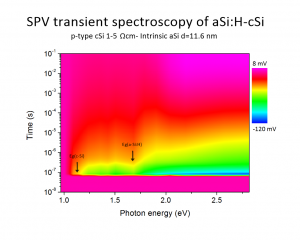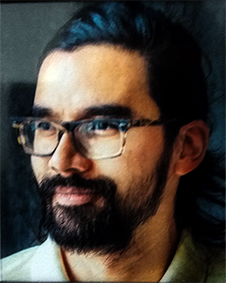
“We live in the silicon era.” Silicon is still by far the most widely used PV material. The latest 2017 world record solar cell for Silicon heterostructures (HIT) achieved an ECE of 26.63%. At its hearth, the materials used are amorphous-Silicon hydrogen passivated and crystalline silicon (aSi:H-cSi). Such an interface showcases interesting electrical and electro-chemical properties. Evidence of its potential capabilities for reducing defect densities and their photon absorption with its two energy band gaps have been observed. Both phenomena, if correctly engineered, are known to help increase efficiency[1]. Our curiosity driven investigation by surface photovoltage (SPV) spectroscopy and by SPV transient measurements may lead our team to a better understanding of the hierarchy of photo electric and photo chemical processes at this amazing interface and thus further contribute to extend the so-called Silicon era we’re living in.
[1] New World Record Established for Conversion Efficiency in a Crystalline Silicon Solar Cell. Conversion Efficiency of 26.63% Achieved in a Practical Cell Size- New Energy and Industrial Technology Development Organization (NEDO) Kaneka Corporation [Online]. Available http://www.kaneka.co.jp/en/service/news/nr201708252/ [Accessed Sept 9th, 2017].

Author:
Santiago Pineda
Technische Universität Berlin
Global Production Engineering for New Energy Technologies
HZB-Summer Student 2017
Institute for Silicon Photovoltaics
Helmholtz-Zentrum Berlin, Germany

Super headline. It immediately motivates me to read the text – and I am pleased to find there an answer to the question of the headline. The image looks colorful, but has to be interpreted.
https://imgur.com/a/UDBw6
If you follow this link i try to answer what i understood from your comment. Thanks
very interesting topic.
Ooh , it’s a function in 2 variables maybe ?
This is the first time I see the parameter time in the y-axis 😀 , Could you illustrate what the graph indicates ?
Good post! It sounds very interesting. I’d like to hear more!!
I would like to hear more about that 🙂